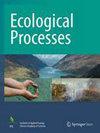Grazing effects on vegetation dynamics in the savannah ecosystems of the Sahel
IF 3.9
2区 环境科学与生态学
Q1 ECOLOGY
引用次数: 0
Abstract
The savannah ecosystems of Sahel have experienced continuous and heavy grazing of livestock for centuries but still, their vegetation response to grazing pressure remains poorly understood. In this study, we analysed the herbaceous plant dynamics, measured by species diversity, composition, cover, and biomass in response to grazing pressure in the savannah ecosystems of Sahel. In Senegal, we selected four savannah sites represented with high, moderate, light and no grazing intensity levels. Transect survey methods were used for sampling the vegetation data within each of the sites. Species richness and composition were analysed using species accumulation curve and multivariate analyses. Furthermore, we used General Linear Models and a piecewise Structural Equation Model (pSEM) to examine the relationships between grazing intensity, vegetation cover, diversity and biomass. The herbaceous species diversity and composition varied significantly among the different grazing intensity levels (p <0.001). The plant species composition shifted from the dominance of grass cover to the dominance of forb cover with increasing grazing pressure. Moreover, the attributes of species diversity, herbaceous biomass, and ground cover were higher on sites with low grazing than sites with high and moderate grazing intensity. Across all sites, species diversity was positively related to total biomass. The pSEM explained 37% of the variance in total biomass and revealed that grazing intensity negatively influenced total biomass both directly and indirectly through its negative influence on species diversity. Managing grazing intensity may lead to higher plant production and higher mixed forage establishment in the dryland savannah ecosystems. This information can be used to support land management strategies and promote sustainable grazing practices that balance the needs of livestock with the conservation of ecosystem health and biodiversity.放牧对萨赫勒草原生态系统植被动态的影响
几个世纪以来,萨赫勒草原生态系统经历了持续和大量的牲畜放牧,但其植被对放牧压力的反应仍然知之甚少。在本研究中,我们分析了萨赫勒草原生态系统中草本植物对放牧压力的响应,包括物种多样性、组成、覆盖和生物量。在塞内加尔,我们选择了四个草原遗址,分别代表高、中等、轻度和无放牧强度水平。采用样带调查方法对每个站点内的植被数据进行采样。利用物种积累曲线和多变量分析对物种丰富度和组成进行了分析。利用一般线性模型(General Linear Models)和分段结构方程模型(piecwise Structural Equation Model, pSEM)分析了放牧强度、植被覆盖度、多样性和生物量之间的关系。不同放牧强度下草本物种多样性和组成差异显著(p <0.001)。随着放牧压力的增加,植物种类组成由草被为主向草被为主转变。低放牧区的物种多样性、草本生物量和地被盖度均高于高放牧区和中等放牧区。所有样地的物种多样性均与总生物量呈正相关。该模型解释了总生物量变化的37%,揭示了放牧强度通过对物种多样性的负向影响直接和间接地对总生物量产生负向影响。管理放牧强度可以提高旱地草原生态系统的植物产量和混合饲料的建立。这些信息可用于支持土地管理战略和促进可持续放牧做法,以平衡牲畜的需求与保护生态系统健康和生物多样性。
本文章由计算机程序翻译,如有差异,请以英文原文为准。
求助全文
约1分钟内获得全文
求助全文
来源期刊

Ecological Processes
Environmental Science-Ecological Modeling
CiteScore
8.50
自引率
4.20%
发文量
64
审稿时长
13 weeks
期刊介绍:
Ecological Processes is an international, peer-reviewed, open access journal devoted to quality publications in ecological studies with a focus on the underlying processes responsible for the dynamics and functions of ecological systems at multiple spatial and temporal scales. The journal welcomes manuscripts on techniques, approaches, concepts, models, reviews, syntheses, short communications and applied research for advancing our knowledge and capability toward sustainability of ecosystems and the environment. Integrations of ecological and socio-economic processes are strongly encouraged.
 求助内容:
求助内容: 应助结果提醒方式:
应助结果提醒方式:


